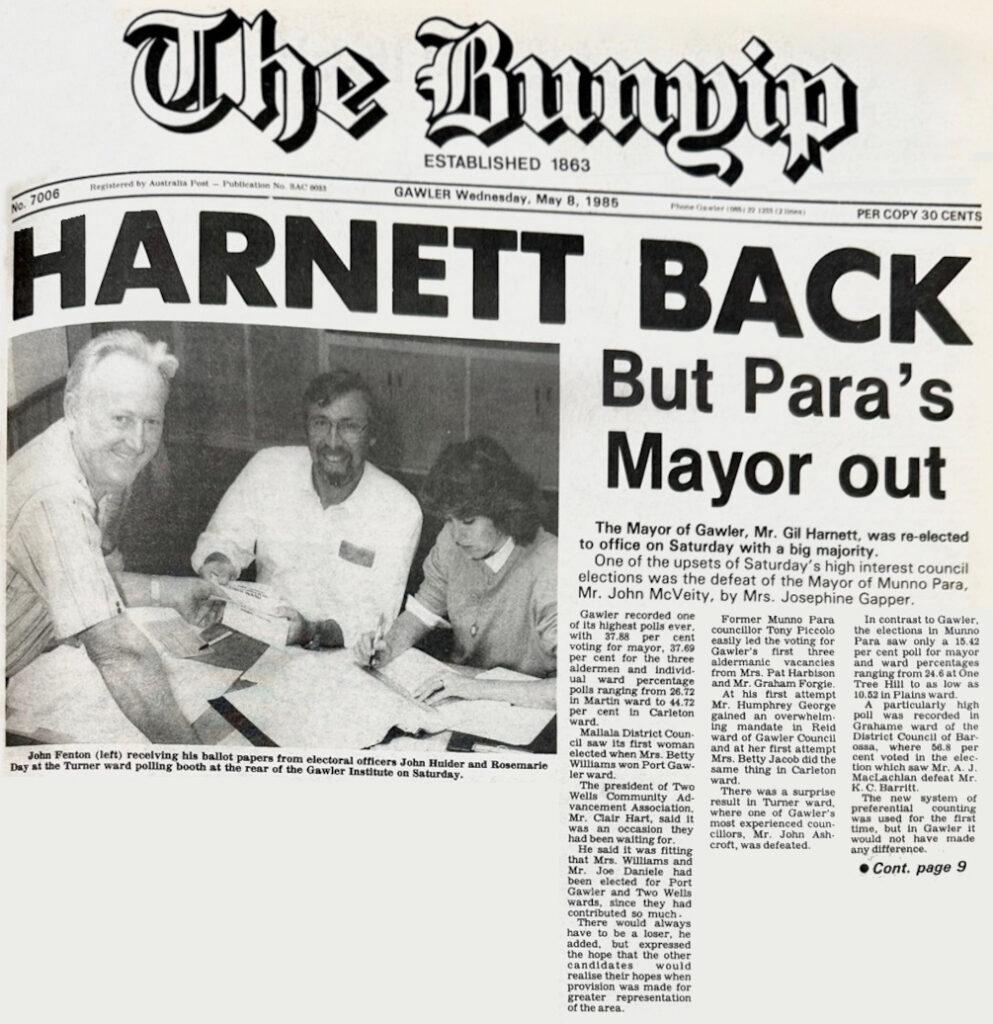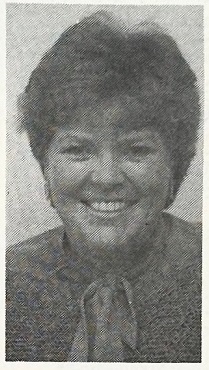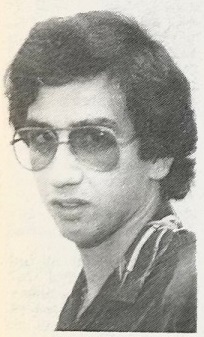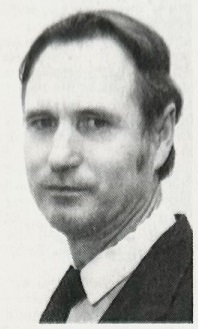1985. Neighbours was in its first season on TV, and Kate Bush had just released a song that would not hit #1 on the Australian music charts until 37 years later, when it was featured on the fourth season of Stranger Things.
It was also the year that Gawler changed its Council boundaries, but I won’t be covering that here, as I’ve already covered it in a separate post. Here’s a fun fact that didn’t make it into that post: There was a brief attempt to rename the Town of Gawler to the City of Gawler, but it was defeated in a Council vote.

The Bunyip Newspaper, March 13th, 1985.
The photo is unrelated, but I kept it in because the photo of someone having their mind blown by a new Commodore 64 computer network really sets the scene for the era we are covering this time around.
Before the Elections
Councils were debating more than just boundaries in the lead-up to the 1985 Council elections. The State Government had also started to enforce rules around conflicts of interest, preventing Councillors from being able to vote on matters that would further their own personal financial interests.
How did Elected Members at the time react to new legislation requiring them to disclose a register of their private financial interests? In Gawler’s case, it split the Council down the middle, with a motion of opposition passing on the casting vote of the Mayor after a 6-6 tied vote.

The Bunyip, November 23rd, 1983.
In the modern day, learning that this policy was ever controversial gave me a level of culture shock.
People clearly shouldn’t be able to use Council decisions to increase the value of their personal property in secret – that would undermine the residents’ trust that the Council is making fair decisions in the best interests of the wider community.
That said, I’ve been doing my best to be gracious and keep in mind the historical context of all this. It’s not that Councils in 1985 were particularly more entitled than any previous Council. This was how local government had always operated.
Councils often had a steady supply of major landholders and main street traders to fill Councillor roles. They would get little to no personal compensation for the position but, in exchange, would be able to shape real estate decisions around the town. This was as true (if not more) of Gawler’s founding fathers, like James Martin, as it would be of later councils.

The Bunyip, September 26th, 1984.
This article is notable for a couple of reasons. Firstly, “a gross violation of the democratic rights of citizens” seems a tad bit dramatic for the actual legislation being proposed. Also, I feel like Cr. Bartlett really missed out on a perfect opportunity here to reference the dystopian George Orwell novel 1984; maybe that just wasn’t as popular to say back in 1984.
The article is helpful, however, in giving us some broader context on how Councils across the state were processing the changes: poorly, it seems. By this point, two members of the Angaston Council had already resigned in protest, and Bartlett argues that a vast majority of Councils were unhappy with the proposal (though I can’t fully confirm that statement’s accuracy).
This view was not isolated to Elected Members; journalists such as Bunyip Newspaper columnist Cit also argued that it was a bad idea, claiming that it would “place a stigma” on wealthy people who may want to run for Council.

The Bunyip, November 16th, 1983.
This claim that the government was enacting “creeping socialism” must have been surprising news to socialism, which was off somewhere else minding its own business. If the definition of socialism is “not being allowed to do insider trading anymore”, then that certainly leaves me with a lot of questions about the Cold War.
I think it is best to respond to Cit’s letter with another reference from the 1980s, in the form of that decade’s greatest film:

Unfortunately, the idea that Councillors run in order to further their own private interests has continued somewhat into the modern day; I still meet people who say that Council Members are “just there to feather their own nests”.
At first, I thought this sentiment might just come from a general distrust of government. After all, Councillors not only have to follow strict conflict-of-interest rules but, under current state government regulations, are cut off from the development approval process almost entirely.
However, if you lived through these times, then I can understand some cynicism. It seems that the rules and regulations around local government really have changed for the better in recent decades.
The Mayoral Election
Gil Harnett won a contested election when he became mayor in 1978 but had not faced a challenge in the seven years since. This was about to change.
The challenger was incumbent Councillor Philip Gue, who had been a Ward Councillor for the past six years. With half the population being new to the Council area at this election (thanks to boundary changes), this was as good a time as any to launch a challenge.

The Bunyip Newspaper, April 11th, 1985.
As for Gue’s reasons for running, the above newspaper ad is a good indication of his priorities. In his campaign announcement, he provocatively noted that in the mayoral role, “personal interests must not be placed before the interest of the community”.
Combine this with his bolding of “all people of Gawler” in his campaign ad, and it’s fairly clear what his grievances are. It was not only in hindsight that the question of whether property developers had too much power was a hot topic; there were pockets of the community chafing against it at the time, too.
This attack did not go unnoticed by supporters of Mayor Harnett, one of whom quickly rebutted in the next week’s Letters to the Editor section.

The Bunyip Newspaper, March 27th, 1985.
For his part, Mayor Harnett had several recent achievements to promote, not the least of which was the success of boundary reform under his tenure as Mayor. His campaign slogan read: “Return Gil Harnett as Mayor of Gawler for continued, stable leadership”.
The Mayoral Election Results

The Bunyip Newspaper, May 8th, 1985.
In the end, Gil Harnett was re-elected with around 70% of the vote: 2213 votes to 949. Mayor Harnett would not be challenged again for the position of Mayor until he stepped down from the position in 1989.
When the new Council had its first meeting, it also internally elected its new Deputy Mayor, Alderman Pat Harbison, in a contest against former Deputy Mayor Graham Forgie.
The Councillor Elections
This was a big year for Councillor elections: in fact, for the first time on this blog, every ward was contested. This was not surprising, given how different the new borders were; it was not only the Council boundaries that had changed, but all of the wards too.
Gone were the wards of Church Hill, Barossa, Gawler South, Central, Evanston and Willaston. In their places were the new wards of Martin, Reid, Turner, Carleton and Willaston (the only ward to keep its name). Also new was the addition of three Alderman positions, elected at large by the entire Council area.
Rather than the previous system of thirteen Elected Members (twelve ward councillors and a mayor), it had increased to fourteen (ten ward councillors, three aldermen, and a mayor). Here’s a photo of the new and improved Council:

The Bunyip Newspaper, May 29th, 1985.
I’m still not sold on the phrase “an historic” (we don’t pronounce historic with a silent “h”), but that’s a grammatical argument for another day.
As mentioned in the article, another point of excitement for returning Councillors was that they no longer had to meet in what they had termed “the dungeon”, a small and particularly damp room in the basement of the Town Hall. I believe it’s the room now used for the Gawler Club to play pool in.
Now, onto the actual elections. As usual, if you want to read all of the candidate profiles, you’re welcome to click through and view the pages at full size.



The Alderman Elections
If you haven’t heard of Aldermen, that’s no big surprise; the position existed for only eight years, between 1985 and 1993. A position with the same name had also briefly existed on the formation of the Council in 1857, but was not quite the same thing.
Functionally, you can understand the position as being Area Councillors (the way Gawler currently operates), except that they co-existed with Ward Councillors. Like the position of Mayor, it required a term’s previous experience on a council in order to run.
In this election, there were five candidates for three positions.

Winner (1033 votes): Tony Piccolo
- Evanston Ward Councillor on the Munno Para Council since 1981.
- This was his first time in Gawler Council elections; the 1985 boundary changes had brought him into the Council area.

Winner (829 votes): Pat Harbison
- Ward Councillor since 1979 (Central Ward).
- Would be appointed Deputy Mayor after the election.

Winner (708 votes): Graham Forgie
- Ward Councillor since 1969 (Church Hill Ward).
- Fourth-generation successor of the prominent local family business, Taylor and Forgie Funeral Directors.

Missed out (293 votes): Colin Pearce
- Tony Piccolo’s fellow ward representative in Munno Para Council’s Evanston Ward, had been there eight years.

Missed out (234 votes): Stanley Isaacson
- Ward Councillor since 1980 (Barossa Ward)
Three Gawler Councillors and two (newly displaced) Munno Para Councillors ran. Tony Piccolo and Pat Harbison were elected on first preferences; Graham Forgie was elected after preferences were distributed. 37.69% turnout.
Carleton Ward
Carleton Ward best maps with the former Barossa Ward: that is, covering (a newly expanded) Gawler East. However, neither incumbent contested this ward, as Philip Gue had run unsuccessfully for Mayor and Stanley Isaacson had run unsuccessfully for Alderman.
There were five candidates for two positions.

Winner (317 votes): Betty Jacob
- Had lived in the area for the past 38 years.
- Her candidate summary mentions concerns about factionalism in the council and an “us and them” situation that had developed in the chamber.

Winner (157 votes): Geoffrey Watson
- 32-year-old accountant.
- Interested in contributing to future planning around the Council’s new areas.

Missed out (90 votes): Joan Fogden
- Born in Gawler and grew up in Roseworthy.
- Involved in a large number of community groups and committees in the area.

Missed out (82 votes): Ellen Brien
- A local resident who had been living in the area for the past eight years.
- Issues mentioned in her candidate summary include heritage area zoning and avoiding high-density living.

Missed out (40 votes): Giuseppe Gigliotti
- Gawler South Ward Councillor for the past two years.
- That said, the 1983 election was a total non-event (none of the elections were contested) so he may not have built up much of an incumbency advantage.
44.72% turnout.
Willaston Ward
Like the old Willaston Ward, it is primarily composed of the suburb of Willaston, but for population-balancing purposes, this new iteration also incorporates the Church Hill area of Gawler.

Winner (206 votes): Narelle Martin
- Degree in Economics.
- Mentioned a focus on footpaths, kerbs, gutters, etc, for the people of Willaston Ward.

Winner (157 votes): Ron Folland
- Willaston Ward Councillor since 1981.
- Born in the area, lives in the ward, and works at the Gawler Post Office.

Missed out (124 votes): Graham Hein
- Willaston Ward’s other incumbent Councillor, since 1980.

Missed out (115 votes): Terry Masters
- Resident for the past three years.
- Works at the Engineering and Water Supply Department in Elizabeth.
39.5% turnout.
Turner Ward
Turner Ward encompassed Murray Street itself, as well as much of Gawler South.

Winner (279 votes): Bob Bartlett
- Evanston Ward Councillor since 1982.
- Would go on to become Gawler’s next Mayor in 1989.

Winner (262 votes): Valerie Gravestock
- Gawler South Ward Councillor since 1980.
- Teacher at Gawler Primary School.

Missed out (115 votes): John Ashcroft
- Central Ward Councillor for the past 16 years.
- Would make a return to the Council in 1991.

Missed out (31 votes): Tony Willcock
- Local business owner from Tony’s Bazaar, a second-hand store on Tod Street.
- No picture provided.
43.45% turnout.
Martin Ward
Martin Ward split the new southern areas with Reid Ward, taking the parts to the west of the railway line, like Evanston Gardens.

Winner (208 votes): Danny Bombadieri
- Youngest successful Councillor, at 22. May be a record for youngest Gawler Councillor (which would have been broken in 2022 by Ethan White).
- Degree in Agricultural Science

Winner (207 votes): Keith Bugg
- A 33-year-old who had lived in Gawler for the past ten years.
- Issues included maintenance of the green belt and conservation of heritage areas.

Missed out (78 votes): Joseph Paroczy
- Has lived in Kudla for the past 27 years.
- Concerned about how little funding the area received when it was in the Munno Para Council.
26.71% turnout.
Reid Ward
Reid Ward took in some southern parts of the old Gawler, but its population was mostly concentrated in the Evanston Park area.

Winner (512 votes): Humphrey George
- Local business owner and pharmacist.
- A record of active involvement with groups like the Gawler Chamber of Commerce.

Winner (119 votes): Robert Towers
- Interested in getting the basics right: footpaths, roads etc.

Missed out (55 votes): Graham Horrocks
- Has lived in Gawler for past four years.
- Descendant of early Gawler pioneer John Horrocks (whom Horrocks Highway is named after)
38.48% turnout.
Piccolo vs Eastick: Origins
In my post about the 2000 Gawler Mayoral Election between Bruce Eastick and Tony Piccolo, I noted that they had actually faced off twice before, in 1985 and 1989, at the state government level.
This was the year of that first contest. At the time, Bruce Eastick had been the Member for Light for the past 15 years, and Tony Piccolo had just become an Alderman on the Gawler Council.

The Bunyip Newspaper, December 4th, 1985.
Interestingly, we do have booth-by-booth results for the election (which Eastick won overall with 59.3% of the two-party-preferred vote).

The Bunyip Newspaper, December 11th, 1985.
Piccolo won a few local booths like Evanston and Gawler South but was ultimately blown out of the water in rural areas like Nuriootpa and Tanunda, where the Liberal Party (and Eastick himself) had a strong advantage.
Parking Wars
Speaking of Tony Piccolo, it wasn’t long into his first term at Gawler when the arguments began.

The Bunyip Newspaper, December 4th, 1985.
Cr. Humphrey George was clearly furious at the motion presented to Council, describing it as “three pages that prove Alderman Piccolo is out of touch with reality” and declaring, “you have not heard the last of this” to the loud clapping of supporters in the gallery.
While my blog about 1985 is done for now, you have not heard the last of me, either; next time, we will venture into the older wards system by covering the Gawler Council elections of 1982 and 1983.